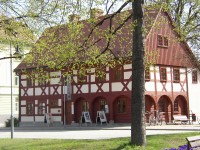Die kleine Dose hat einen rosafarbenen Plastikdeckelverschluss. Auf dem aufgeklebten Etikett steht neben dem Inhalt "Z.-A. Wundsalbe" noch die Herkunft der Dose: "Zinzendorf-Apotheke Inh. W. Müller Niesky O/L.
Schon seit 1765 befand sich die Apotheke der Brüdergemeine am Zinzendorfplatz 12 und wurde bis 1945 von verschiedenen Apothekern geführt. Als im Jahre 1930 der Görlitzer Apotheker Müller die Apotheke übernahm, erhielt sie den Namen "Zinzendorf-Apotheke". Das Gebäude direkt an der Ecke zur Ödernitzer Straße wurde im April 1945 zerstört.
en

















